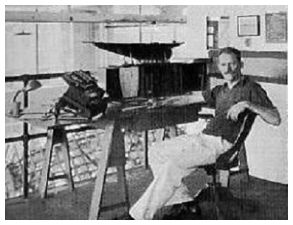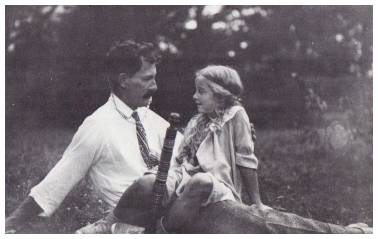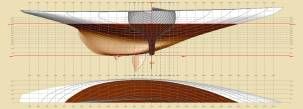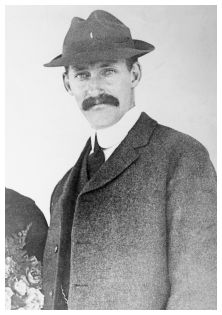Yves GARY Hits: 7482
Category: DESIGNERS
 W. Starling Burgess was born in 1878, and was an aeronautical engineer and naval architect. His father, Edward Burgess, designed the America's cup defenders PURITAN, MAYFLOWER and VOLUNTEER. Orphaned by the age of 12, after his parents died within months of each other (typhoid Fever, pneumonia), Burgess was raised by relatives, and mentored by many of his father’s legendary colleagues, including George Lawley Jr,...
W. Starling Burgess was born in 1878, and was an aeronautical engineer and naval architect. His father, Edward Burgess, designed the America's cup defenders PURITAN, MAYFLOWER and VOLUNTEER. Orphaned by the age of 12, after his parents died within months of each other (typhoid Fever, pneumonia), Burgess was raised by relatives, and mentored by many of his father’s legendary colleagues, including George Lawley Jr,...
 ... Arthur Binney, and Nathanael Greene Herreshoff, assuring him of future success in yacht design. Burgess was educated at Harvard University, and in 1904 entered his father's profession by opening a yard at Marblehead, Massachusetts, where he designed and built small boats. In 1909 he became interested in aviation and constructed a plane in which he made the first flight in New England. Having sold his plane, he engaged in the manufacture of airplanes with Norman Prince, who helped found the Lafayette Escadrille during the First World War.
... Arthur Binney, and Nathanael Greene Herreshoff, assuring him of future success in yacht design. Burgess was educated at Harvard University, and in 1904 entered his father's profession by opening a yard at Marblehead, Massachusetts, where he designed and built small boats. In 1909 he became interested in aviation and constructed a plane in which he made the first flight in New England. Having sold his plane, he engaged in the manufacture of airplanes with Norman Prince, who helped found the Lafayette Escadrille during the First World War.
They were the first civilian pupils of the Wright brothers, receiving a license to manufacture and sell under their patents for a number of years. They soon began to manufacture airplanes for the army and navy, and on June 3, 1911, with Greely S. Curtis and Frank H. Russell,  he organized the Burgess Co., for the production of airplanes, hydroplanes, seaplanes, and flying boats. In October 1911 he fitted a biplane with pontoons and was the first to begin and end a flight on the water.
he organized the Burgess Co., for the production of airplanes, hydroplanes, seaplanes, and flying boats. In October 1911 he fitted a biplane with pontoons and was the first to begin and end a flight on the water.
At the outbreak of the First World War, Burgess sold planes to the Canadian government. Later he sold to the British Admiralty forty-eight pusher biplanes of a radical design. Business increased rapidly, and when America entered the First World War, Mr. Burgess sold the company to John N. Willys. He then spent the war years designing aircraft for the U.S. Navy with the rank of Lieutenant Commander.
 After the war Starling Burgess returned to boat construction, and in 1920 was engaged to re-rig Alexander Smith Cochran's VANITIE for tests to select the America's Cup defender for that year. Two years later, with Frank C. Paine, later the designer of the cup sloop YANKEE, and A. Loring Swasey, he formed the firm of Burgess, Swasey & Paine in Boston, including among his draftsmen L. Francis Herreshoff. The firm turned out many well-known yachts, including the ADVANCE for John S. Lawrence, the GOSSOON for Charles Francis Adams, and the ELLEN for Charles Foster. In 1926 the firm of Burgess, Swasey & Paine was dissolved and Mr. Burgess joined the firm of Burgess & Morgan, Ltd., naval architects in New York City. In 1928 he designed for Paul Hammond the racing schooner NINA. In 1930 Mr. Burgess designed the successful America's Cup defender ENTERPRISE for Harold S. Vanderbilt and his syndicate, embodying in it many radical principles, including a mast and struts of duralumin. He also designed the successful defender RAINBOW for the same syndicate in 1934. The sloop RANGER, which he designed for Vanderbilt in 1937, sailed to four successive victories in defending the America's Cup.
After the war Starling Burgess returned to boat construction, and in 1920 was engaged to re-rig Alexander Smith Cochran's VANITIE for tests to select the America's Cup defender for that year. Two years later, with Frank C. Paine, later the designer of the cup sloop YANKEE, and A. Loring Swasey, he formed the firm of Burgess, Swasey & Paine in Boston, including among his draftsmen L. Francis Herreshoff. The firm turned out many well-known yachts, including the ADVANCE for John S. Lawrence, the GOSSOON for Charles Francis Adams, and the ELLEN for Charles Foster. In 1926 the firm of Burgess, Swasey & Paine was dissolved and Mr. Burgess joined the firm of Burgess & Morgan, Ltd., naval architects in New York City. In 1928 he designed for Paul Hammond the racing schooner NINA. In 1930 Mr. Burgess designed the successful America's Cup defender ENTERPRISE for Harold S. Vanderbilt and his syndicate, embodying in it many radical principles, including a mast and struts of duralumin. He also designed the successful defender RAINBOW for the same syndicate in 1934. The sloop RANGER, which he designed for Vanderbilt in 1937, sailed to four successive victories in defending the America's Cup.
 In 1935 Mr. Burgess became a consulting naval architect for the Aluminum Company of America with his office at the Bath Iron Works, and engaged in promoting a wider use of corrosion-resisting alloys for ship construction. The ALUMETTE, an all aluminum section of a ship complete with propellers, was designed by him and built at the Bath Iron Works. The structure was launched in 1935 and kept continuously afloat in salt water at Newport News for testing the durability of aluminum.
In 1935 Mr. Burgess became a consulting naval architect for the Aluminum Company of America with his office at the Bath Iron Works, and engaged in promoting a wider use of corrosion-resisting alloys for ship construction. The ALUMETTE, an all aluminum section of a ship complete with propellers, was designed by him and built at the Bath Iron Works. The structure was launched in 1935 and kept continuously afloat in salt water at Newport News for testing the durability of aluminum.
On November 1, 1937 Mr. Burgess' design for an all aluminum high speed destroyer was presented to the U. S. Navy. Orders to build the vessel were issued by the Secretary of the Navy in November 1941, only to be countermanded a month later when the United States entered World War II. During the war Mr. Burgess was employed as a civilian engineer by the Special Devices Division, Bureau of Aeronautics of the Navy, and assigned to the Anti-Submarine Development Detachment, U. S. Atlantic Fleet. His work with the Navy was a confidential nature, largely consisting of the design of special devices for Anti-Submarine warfare. By 1946 Mr. Burgess was at the Stevens Institute of Technology, where he was involved with damage control research.
 Burgess married 5 times. He first married to Helene Adams Willard (1882-1902) in 1901. In 1904 he married Rosamond Tudor (b.1878), the portrait artist and granddaughter of Frederic Tudor. Tudor and Burgess had 3 children: sons Edward (1905-1910), who drowned after falling off their boat and Fredrick(b.1907); daughter Starling (b.1915-2008). Starling later changed her name to Tasha Tudor. Burgess’s married Else Foss in 1925 and had two children, Diana and Ann. He subsequently wed Nannie Dale Biddle in 1933 and Majorie Young in 1945.
Burgess married 5 times. He first married to Helene Adams Willard (1882-1902) in 1901. In 1904 he married Rosamond Tudor (b.1878), the portrait artist and granddaughter of Frederic Tudor. Tudor and Burgess had 3 children: sons Edward (1905-1910), who drowned after falling off their boat and Fredrick(b.1907); daughter Starling (b.1915-2008). Starling later changed her name to Tasha Tudor. Burgess’s married Else Foss in 1925 and had two children, Diana and Ann. He subsequently wed Nannie Dale Biddle in 1933 and Majorie Young in 1945.
A friend of his last wife, Marjorie Young, described Burgess: “With all his brilliance, he is a child, and that is part of his charm. He will not face hard facts, but will hide from them and will love the person who shields him from them.”
W. Starling Burgess died in 1947.

 |
 |
 |
| ENTERPRISE - 1930 | RAINBOW - 1934 | RANGER - 1937 |

 William Starling Burgess - Wikipedia, the free encyclopedia
William Starling Burgess - Wikipedia, the free encyclopedia